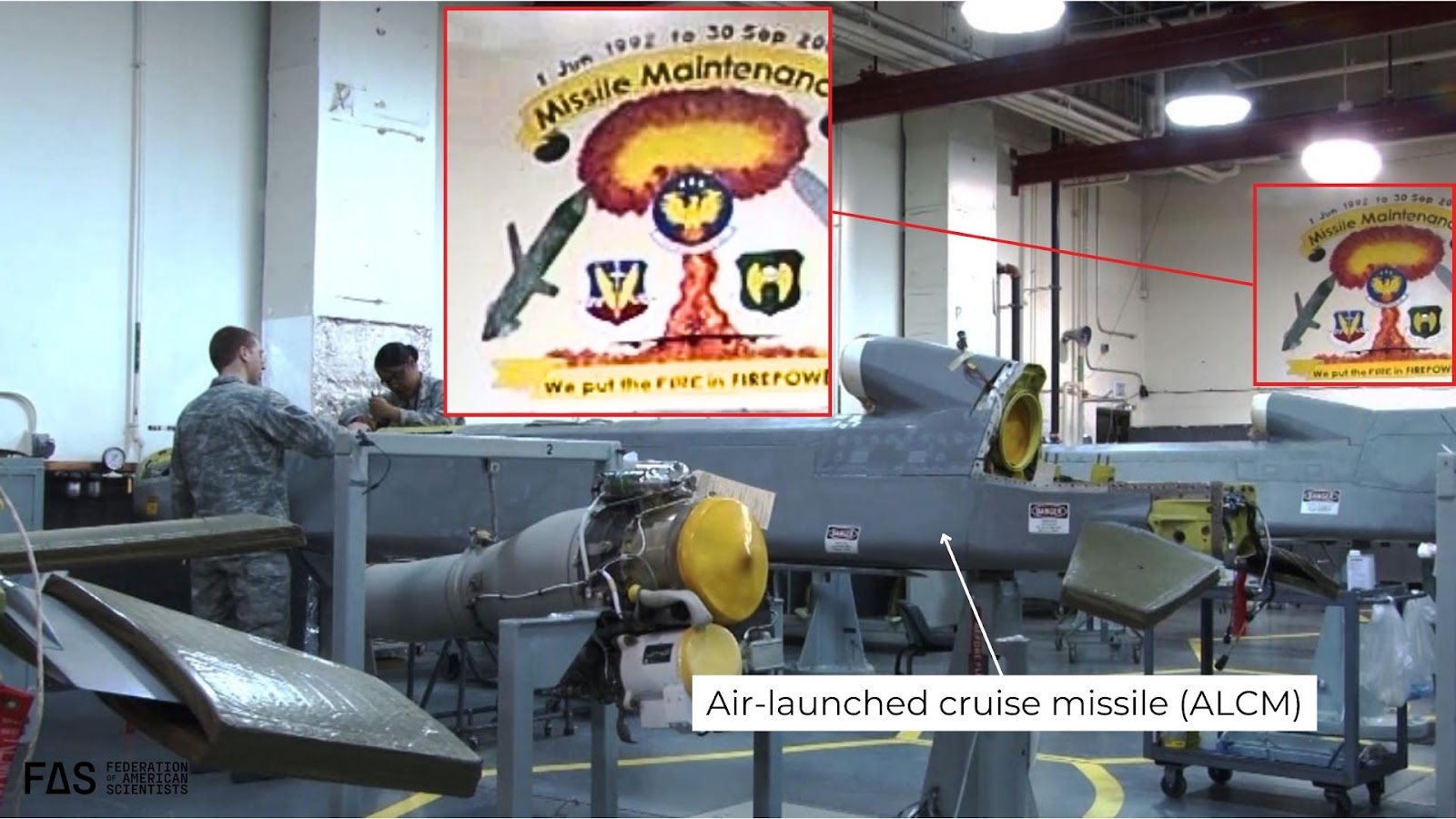
Construction Of New Nuclear Weapons Facility At Barksdale AFB
Satellite images show that the Navy has begun construction of a new nuclear weapons storage and handling facility at Barksdale Air Force Base in Louisiana. The construction of this facility is part of a larger effort by the U.S. Air Force to expand the number of strategic bomber bases that can store nuclear weapons.
The Weapons Generation Facility (WGF), once complete, will reinstate the capability to store nuclear weapons at Barksdale AFB, home to the 2nd Bomb Wing with B-52H bombers. The capability was lost approximately 20 years ago when the Air Force decided to consolidate storage of nuclear air-launched cruise missiles (ALCM) to Minot Air Force Base in North Dakota.

Image from US Air Force of inside ALCM maintenance facility at Barksdale AFB in 2013. The insignia on the wall shows a mushroom cloud and slogan reading “We put the FIRE in FIREPOWER.”
Our assessment that the new construction visible on satellite imagery is of the planned nuclear weapons storage and handling facility is bolstered by several open sources. A draft environmental assessment from 2017 reveals the Air Force’s plans to construct a WGF (at the time referred to as Weapons Storage and Maintenance Facilities [WSF]) at Barksdale AFB, the construction is occurring within the double-fence perimeter that housed Barksdale’s past nuclear weapons storage capability, and the construction area corresponds to the approximate size of the new complex detailed in publicly-available contract documents. Additionally, contract timelines and details correspond to activity at the site (See Figure 1), and the building foundation visible from satellite imagery corresponds to digital mockups of the facility seen in the background of photos from the WGF groundbreaking ceremony shared by DVIDS (See Figure 2).

Construction activity over time at Barksdale AFB corresponds to contract details
SLSCO, LTD was contracted in mid-2022 for preparatory work including land clearing, building demolition, and construction of secure fencing – activity which can be seen in June 2023 imagery and which was set to be complete by September 2023. B.L Harbert International, LLC was contracted in September 2023 for the construction phase of the WGF complex; activity related to construction of the facility is visible shortly after, in November 2023.

New facility foundation at Barksdale AFB construction site in February 2024 corresponds to facility mockup visible in background of groundbreaking ceremony for new WF in November 2022.
Work on the site began in mid-2022 with a $33 million contract to SLSCO, LTD to carry out site preparation via clearing, drainage, building demolition, utilities demolition and relocation, construction of secure fencing, and roadway construction, among other preparatory tasks.
Naval Facilities Engineering Systems Command (NAVFAC) awarded a $210.2 million fixed-price contract to Alabama company B.L. Harbert International, LLC in September 2023 to construct the 28-acre complex, which will include the main building, an approximately 300,000 square foot WGF; an entry control facility; security facility; fire pump building; diesel generator building; weather shelter; and multiple towers for security.
The facility, expected to be completed by January 2026, will house the new nuclear Long-Range Standoff (LRSO) cruise missiles for delivery by B-52H Stratofortress heavy bombers at the base. With the LRSO expected to achieve initial operational capability in 2030, it is possible that the Barksdale WGF will house the nuclear ALCM until it is replaced by the LRSO. The WGF at Barksdale AFB will only be used to store nuclear cruise missiles, because the B-52H bombers are no longer assigned nuclear gravity bombs.

A B-52H Stratofortress with weapons display at Barksdale AFB, showing 20 (unarmed) nuclear ALCMs on pylons and rotary launcher. Source: United States Air Force
The Weapons Generation Facilities are a new type of facility replacing the Cold War-era Weapons Storage Areas (WSA) in order to consolidate weapons storage, maintenance, and training into one building. Barksdale AFB will become the second base to receive a WGF; construction of the first is well underway at F. E. Warren AFB in Wyoming for ICBM warheads. The Air Force also plans to construct WGFs at Ellsworth AFB in South Dakota, Whiteman AFB in Missouri, and Dyess AFB in Texas for the future B-21 bomber mission.
When completed, the number of U.S. heavy bomber bases with nuclear weapons storage capability will have increased from two today (Minot AFB and Whiteman AFB) to five.
This research was carried out with generous contributions from the New-Land Foundation, Ploughshares Fund, the Prospect Hill Foundation, Longview Philanthropy, and individual donors.
The FY2026 National Defense Authorization Act (NDAA) paints a picture of a Congress that is working to both protect and accelerate nuclear modernization programs while simultaneously lacking trust in the Pentagon and the Department of Energy to execute them.
While advanced Chinese language proficiency and cultural familiarity remain irreplaceable skills, they are neither necessary nor sufficient for successful open-source analysis on China’s nuclear forces.
Satellite imagery has long served as a tool for observing on-the-ground activity worldwide, and offers especially valuable insights into the operation, development, and physical features related to nuclear technology.
This report outlines a framework relying on “Cooperative Technical Means” for effective arms control verification based on remote sensing, avoiding on-site inspections but maintaining a level of transparency that allows for immediate detection of changes in nuclear posture or a significant build-up above agreed limits.